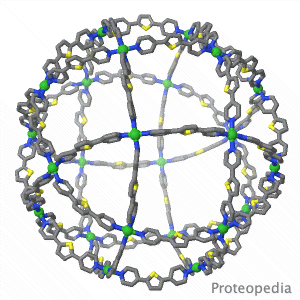Proteopedia:Featured SEL/11
From Proteopedia
(Difference between revisions)
| (3 intermediate revisions not shown.) | |||
| Line 6: | Line 6: | ||
</imagemap> | </imagemap> | ||
</td></tr> | </td></tr> | ||
| - | <tr><td><div class="scrolling">'''Metal-Ligand | + | <tr><td><div class="scrolling">'''Metal-Ligand Nano-Cages'''<br> |
| - | This self-assembling structure consists of 24 palladium ions, each of which is coordinated by 4 nitrogens, which are part of 48 dipyridylthiophene molecules. Such synthetic nano-spheres can be functionalized to create synthetic receptors and nanoreactors. Potential applications in sensing, catalysis, and drug delivery are being explored. | + | This self-assembling structure has an interior cavity about 32 Å in diameter. It consists of 24 palladium ions, each of which is coordinated by 4 nitrogens, which are part of 48 dipyridylthiophene molecules. Such synthetic nano-spheres can be functionalized to create synthetic receptors and nanoreactors. Potential applications in sensing, catalysis, and drug delivery are being explored. |
>>> [[Metal-Ligand Polyhedra|See more animations and explanation]] >>> | >>> [[Metal-Ligand Polyhedra|See more animations and explanation]] >>> | ||
| Line 14: | Line 14: | ||
</table> | </table> | ||
| - | [[Category:Featured in | + | [[Category:Featured in Selected Pages]] |
Current revision
Metal-Ligand Nano-Cages
This self-assembling structure has an interior cavity about 32 Å in diameter. It consists of 24 palladium ions, each of which is coordinated by 4 nitrogens, which are part of 48 dipyridylthiophene molecules. Such synthetic nano-spheres can be functionalized to create synthetic receptors and nanoreactors. Potential applications in sensing, catalysis, and drug delivery are being explored. |


